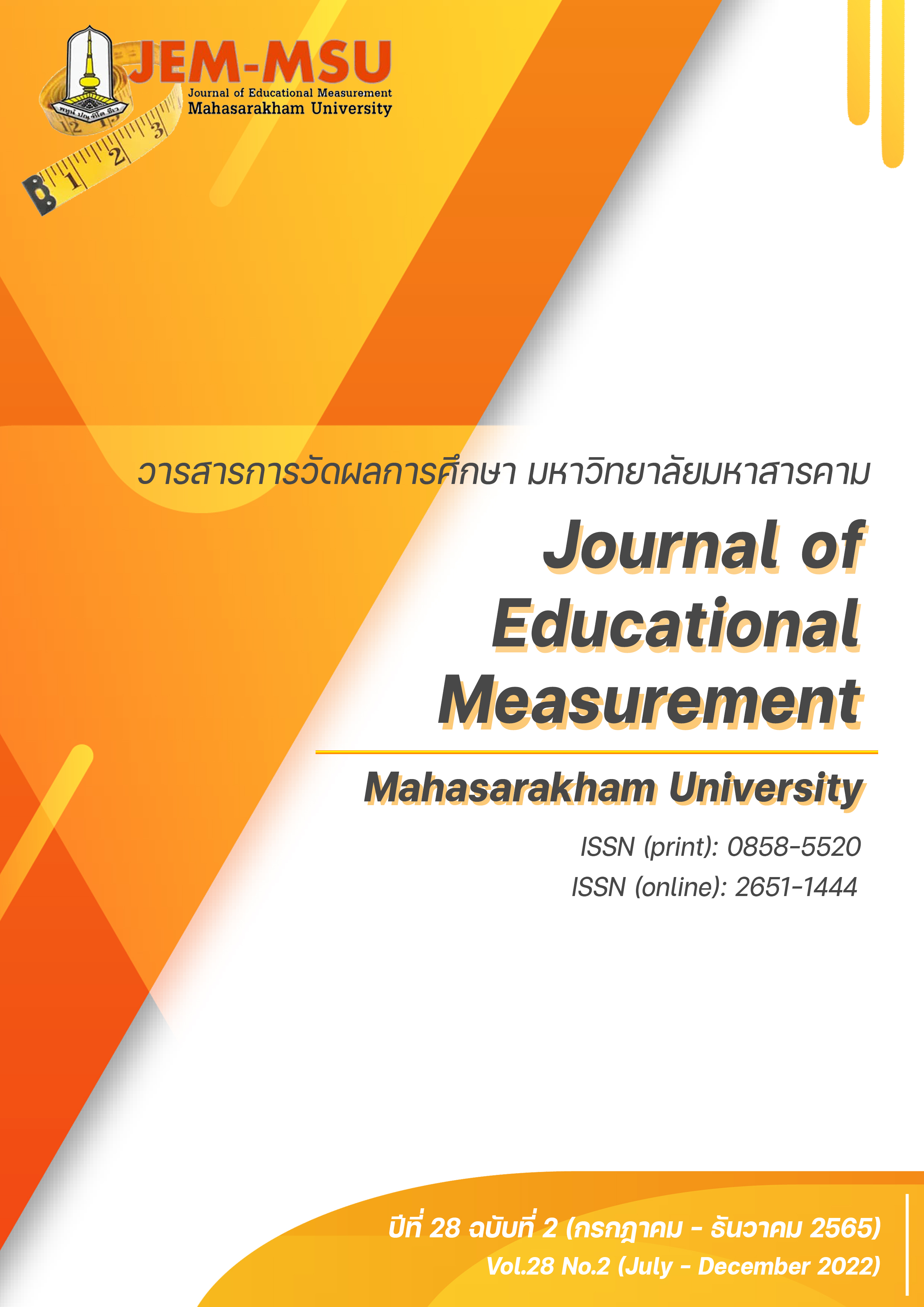Self-evaluation Bias
Main Article Content
Abstract
Self-evaluation bias is the direction of judgement error toward a learner's ability. Learner's self-evaluation bias can be measured with several forms of tools, and learner's self-evaluation can possibly come from different elements. In order to benefit teachers, university teaching staff and researchers in their application of the body of knowledge of self-evaluation bias in student development as well as in research and educational evaluation, this article aims to present the content on the following topics:1) definition and significance of self-evaluation bias; 2) guidelines for self-evaluation bias analysis; and 3) elements influencing self-evaluation bias.
Article Details

This work is licensed under a Creative Commons Attribution-NonCommercial-NoDerivatives 4.0 International License.
The content and information contained in the published article in the Journal of Educational Measurement Mahasarakham University represent the opinions and responsibilities of the authors directly. The editorial board of the journal is not necessarily in agreement with or responsible for any of the content.
The articles, data, content, images, etc. that have been published in the Journal of Educational Measurement Mahasarakham University are copyrighted by the journal. If any individual or organization wishes to reproduce or perform any actions involving the entirety or any part of the content, they must obtain written permission from the Journal of Educational Measurement Mahasarakham University.
References
Admiraal, W., Huisman, B., & Pilli, O. (2015). Assessment in Massive Open Online Courses. The Electronic Journal of e-Learning, 13(4), 207-216.
Alaoutinen, S. (2012). Evaluating the effect of learning style and student background on self-assessment accuracy. Computer Science Education, 22(2), 175-198.
Bol, L., & Hacker, D. J. (2001). A comparison of the effects of practice tests and traditional review on performance and calibration. Journal of Experimental Education, 69(2), 133-151.
Chen, C. S. (2002). Self-regulated Learning Strategies and Achievement in an Introduction to Information Systems Course. Information Technology, Learning and Performance Journal, 20(1), 11-25.
Chung, H. Q., Chen, V., & Olson, C. B. (2021). The impact of self‑assessment, planning and goal setting, and refection before and after revision on student self‑efficacy and writing performance. Reading and Writing, 34, 1885-1913.
Eberlein, M., Ludwig, S., & Nafziger, J. (2010). The effects of feedback on self-assessment. Bulletin of Economic Research, 63(2), 177-199.
Eva, K W., & Regehr, G. (2005). Self-assessment in the health professions: a reformulation and research agenda. Academic Medicine, 80(10), 46-54.
Hale, C. C. (2015). Self-assessment as academic community building: a study from a Japanese liberal arts university. Language Testing in Asia, 5(1), 1-12.
Ip, W. Y., Lui, M. L., Chien, W. T., Lee, I. F., Lam, L. W., & Lee, D. T. (2014). Promoting self-reflection in clinical practice among Chinese nursing undergraduates in Hong Kong. Contemp Nurse, 41(2), 253-262.
Jeong, H., Lee, J., Kim, J., Choen, S., Sohn, K. M., Kim, Y. S., & Kiem, S. (2020). Self-Assessment Questionnaire for Efficient and Safe Evaluation of Patients with Mild COVID-19. Infection & chemotherapy, 52(2), 212–215.
Kelberlau-Berks, D. R. (2006). The effects of self-assessment on student learning. https://digitalcommons.unl.edu/cgi/viewcontent.cgi?article=1007&context=mathmidactionresearch
Klassen, R. (2006). Too much confidence? The self-efficacy beliefs of adolescents with learning disabilities. In Self-efficacy beliefs of adolescents (pp. 181-200). Information Age.
Labuhn, A. S., Zimmerman, B. J., & Hasselhorn, M. (2010). Enhancing students' self-regulation and mathematics performance: The influence of feedback and self-evaluative standards. Metacognition Learning, 5, 173-194.
Madrazo, L., Lee, C. B., McConnell, M., & Khamisa, K. (2018). Self-assessment differences between genders in a low-stakes objective structured clinical examination (OSCE). BMC Research Notes, 11(1), 1-4.
McMillan, J. H., & Hearn, J. (2008). Student Self-Assessment: The Key to Stronger Student Motivation and Higher Achievement. Educational Horizons, 87(1), 40-49.
Pajares, F., & Graham, L. (1999). Self-efficacy, motivation constructs, and mathematics performance of entering middle school students. Contemporary Educational Psychology, 24(2), 124–139.
Pallier, G. (2003). Gender Differences in the Self-Assessment of Accuracy on Cognitive Tasks. Sex Roles, 48(5), 265–276
Peyghambarian, F., Fatemi, M. A., & Ashraf, H. (2015). On the Effect of Online Formative Assessment on Iranian Lower Intermediate EFL Learners Reading Comprehension. International Journal of Applied Linguistics & Literature, 4(2), 189-192.
Ramdass, D. H., & Zimmerman, B. J. (2008). Effects of self-correction strategy training on middle school students’ self-efficacy, self-evaluation, and mathematics division learning. Journal of Advanced Academics, 20, 18-41.
Rawson, K. A., & Dunlosky, J. (2013). Retrieval-Monitoring-Feedback (RMF) Technique for Producing Efficient and Durable Student Learning. International Handbook of Metacognition and Learning Technologies, 28, 67-78.
Scherpereel, C. M., & Bowers, M. Y. (2008). Back to the future: gender differences in self-ratings of team performance criteria. Developments in Business Simulation and Experiential Learning, 35, 170-179.
Schraw, G., Potenza, M. T., & Nebelsick-Gullet, L. (1993). Constraints on the calibration of performance. Contemporary Educational Psychology, 18, 455-463.
Sharma, R., Jain, A., Gupta, N., Garg, S., Batta, M., & Dhir, S. K. (2016). Impact of self-assessment by students on their learning. International Journal of Applied and Basic Medical Research,6(3), 226-229.
Sheldrake, R., Mujtaba, T., & Reiss, M. J. (2014). Calibration of self-evaluations of mathematical ability for students in England aged 13 and 15, and their intentions to study non-compulsory mathematics after age 16. International Journal of Educational Research, 64, 49-61.
Wray, E. (2013). RISE Model. http://www.emilywray.com/rise-model
Yilmaz, F. N. (2017). Reliability of Scores Obtained from Self-, Peer-, and Teacher-Assessments on Teaching Materials Prepared by Teacher Candidates. Educational Sciences: Theory & Practice, 17(2), 395–409.
Ziegler, B., & Montplaisir, L. (2014). Student Perceived and Determined Knowledge of Biology Concepts in an Upper-Level Biology Course. CBE Life Sciences Education, 13(2), 322-330.
Zimmerman, B. J. (2000). Attaining Self-regulation: A Social Cognitive Perspective. Routledge.
Ziv, A. K., Lehrer, K., & Schmid, H. B. (2011). Self-evaluation: Affective and social grounds of intentionality. Springer.

